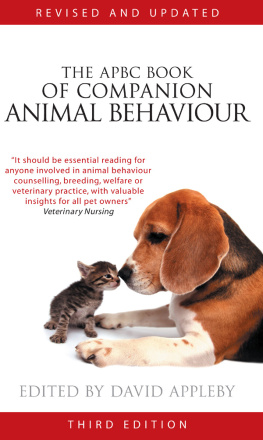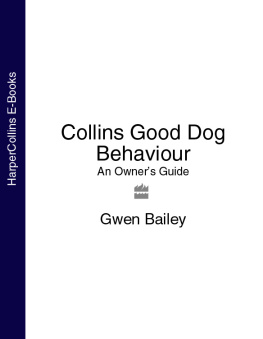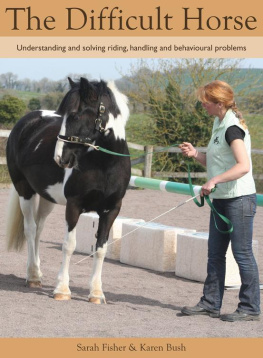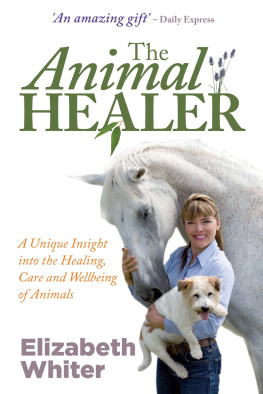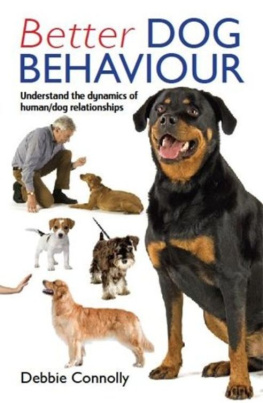The APBC Book of Companion Animal Behaviour
The APBC Book of Companion Animal Behaviour
Third Edition
Edited by David Appleby
SOUVENIR PRESS
First published by Souvenir Press 2004
Revised and updated 2010, 2016
by Souvenir Press Ltd, 43 Great Russell Street, London WC1B 3PD
This ebook edition first published in 2016
All rights reserved 2016 Association of Pet Behaviour Counsellors
The right of David Appleby to be identified as editor of this work has been asserted in accordance with Section 77 of the Copyright, Designs and Patents Act 1988
This ebook is copyright material and must not be copied, reproduced, transferred, distributed, leased, licensed or publicly performed or used in any way except as specifically permitted in writing by the publishers, as allowed under the terms and conditions under which it was purchased or as strictly permitted by applicable copyright law. Any unauthorised distribution or use of this text may be a direct infringement of the authors and publishers rights, and those responsible may be liable in law accordingly
ISBN 9780285643413
Contents
David Appleby, Editor
Jan Hoole
David Appleby and Jolanda Pluijmakers
Erica Peachey
Erica Peachey, Donna Brander and Emma Magnus
Inga MacKellar
Charlotte Nevison and Rosie Barclay
David Appleby and Jolanda Pluijmakers
David Ryan
Sarah Heath
Anne McBride, Emma Magnus and Georgie Hearne
Anthony L Podberscek
Julie M Bedford
Sarah Heath
Donna Brander and Natalie Waran
Anne McBride
List of Illustrations
Introduction
Since I edited the first edition of this book the study of companion animal behaviour and the profession of pet behaviour counselling have continued to advance. Then, as now, there is a long way to go in our search for a full understanding of the various causes for the development of behaviour problems and the treatment methods that are most effective. This 3rd edition has been updated where appropriate to reflect the current thinking of those issues.
Companion Animal Behaviour focuses on the three main companion animals: the dog, cat and rabbit because these are the species that are most commonly presented for the treatment of behaviour problems. Horses are deserving of being included within these pages because there is much to discuss but the focus of this book is the companion animals with which we cohabit. To a large extent, however, the principles discussed in these chapters, such as ethology, learning theory, the importance of appropriate early experience, environment, emotional states and issues relating to welfare and pet ownership can be related to other species.
Although the dog has been overtaken by the cat in its popularity for being kept as a pet it is still the species most frequently seen in behaviour practices, this is reflected in the number of chapters that are dedicated to it.
Although the measure of success in animal training and behaviour modification must include the development of a behaviour that we want or the cessation of one we dont want, it should also be measured by its impact on animal welfare and the pet-owner relationship. This book hopes to further the readers understanding of the important issues.
I would like to thank my APBC colleagues for updating the chapters of this book. Unfortunately, due to ill-health, Sarah Heath was unable to update her chapter Behavioural Problems in Ageing Pets.
David Appleby, Editor
1
Evolutionary Aspects of Canine Behaviour
Jan Hoole
Canine Ecology
Dogs are carnivorous, predatory and social animals, which from an ecological perspective are, like other canine species, near the top of the food web. Wolves, from whom dogs are descended, are very successful as predators, and as with all organisms, the ecological niche they occupy affects the morphology (physical appearance), and the behavioural and social structure of the animal. Since the domestic dog (Canis familiaris) is directly descended from the Grey Wolf (Canis lupus), its physiology and behaviour are strongly influenced by its canine ancestor. Although humans have radically altered dog morphology (body shape) through selective breeding, the physiology and some aspects of instinctive behaviour remain relatively unaltered.
To make sense of the evolution of the dog it is helpful to consider the ecology (how the species interacts with its environment) and behaviour of the wolf. In addition it may be useful to briefly discuss the processes by which evolution takes place with particular reference to how natural selection can act on behaviour. We can then consider the original function of some aspects of behaviour in the wolf and how these have been translated into our domestic companions.
Wolf Ecology, Morphology and Social Systems
The most striking characteristic of the wolf is its adaptation to running. This is true of most of the dog family, much more so than any of the other large carnivores. Of all the Canidae, wolves have the longest legs and the greatest endurance when running down prey. They tend to hunt prey that is much larger than them, and so require help with the kill. Although it does happen from time to time, an individual wolf finds it difficult to bring down an adult reindeer or musk ox, and impossible to tackle moose or bison. By hunting co-operatively they can isolate a weak animal from the herd and join together to bring it down and kill it.
This is not to say that wolves can be considered as small animals, since they are between 26 and 32 inches tall at the shoulder, and males can be as much as six feet five inches long from nose to tail tip. There is however great variation, not only between species of wolves, but also within species, in size, shape, coat and behaviour. Since wolves are exceedingly difficult to observe in the wild little is known about the behaviour of many species, but the Grey Wolf has been the subject of many studies and its social and predatory behaviour has been reasonably well documented. Much of the work has been done on captive and semi-wild populations. However, because of their artificial nature these studies are of limited value (see ) and they can only be interpreted as behaviour in abnormal social and environmental contexts.
Status (Uninhibited/Inhibited Social Behaviour)
The social structure of a wolf pack tends to remain reasonably stable over quite long periods. The structure is hierarchical and is based on individual ability to gain and retain access to resources. A male and female wolf that are without a pack will form a breeding pair, and their offspring become the new pack. In captive packs, where there is often no blood relationship between the members, the situation is different, and in some ways this more accurately reflects the situation in which most dogs find themselves.
The social structure within packs appears to have subcultures based on male and female lines. It appears that within these lines there is a fairly simple resource based hierarchy which becomes apparent as individuals reach social maturity. Pups and immature animals have an additional social structure, which is not determined by gender. Some adults may not even be part of the social structure of the pack and remain on the outskirts. Whether dogs live in social group of the same species, as may hounds, huskies and feral dogs or live in a mixed pack with humans the social structure of the group they live in is established and maintained by communication.

